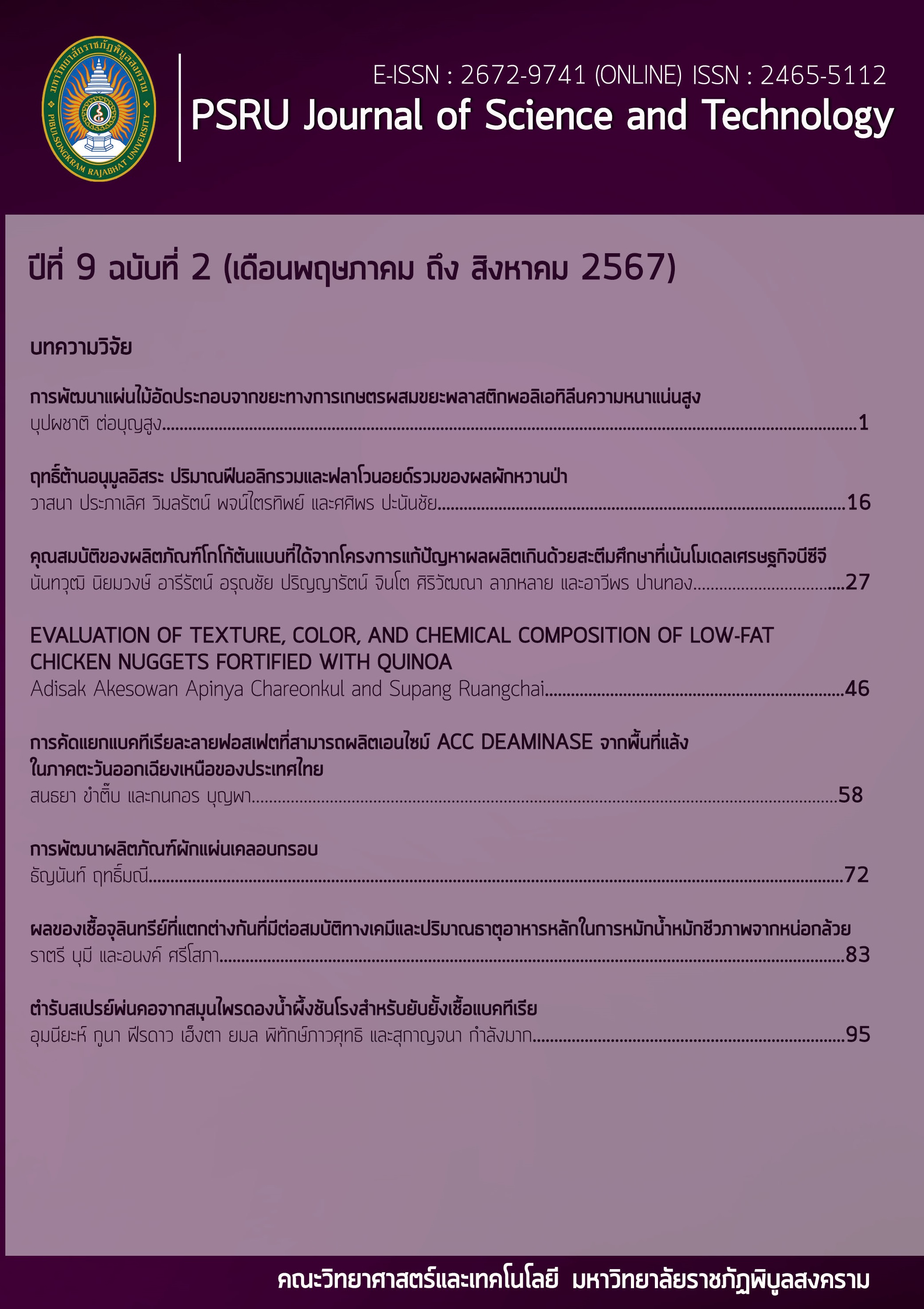THE EFFECT OF DIFFERENT MICROBES ON THE CHEMICAL PROPERTIES AND THE MACRONUTRIENT CONTENTS IN LADY FINGER SHOOTS BIO-EXTRACT FERMENTATION
Keywords:
Biofertilizer fermentation, Microbial types, Macronutrient content, Lady Finger shootsAbstract
This research studied the effect of microbial types on their chemical properties and macronutrient content including nitrogen, phosphorus and potassium in Lady Finger shoots biofertilizer fermentation. The inoculants used in the study were Super PD.2, EM and Lacticaseibacillus casei. Fermentation materials consisted of banana shoots, water, molasses and inoculum in the ratio of 3 : 10 : 1 : 0.025 (by weight) fermented at room temperature without oxygen. The results showed that the physical and chemical changes during the biofertilization process in all experimental batches occurred rapidly during 30 days of fermentation. At the fermentation period of 2 months, bio-fertilizer using microorganisms Super PD.2. EM and Lacticaseibacillus casei show changes in electrical conductivity and acidity were not difference. From the comparison the amount of macronutrients, it was found that the formula containing L. casei inoculum, bio-liquid fertilizer gave higher nutrients N-P-K than the formula without addition. The liquid organic fertilizer formula 3, fermented for 30 days had the highest nitrogen, phosphorus, and potassium contents of 1.045%, 0.547%, and 0.516%, respectively. The means of variance (ANOVA) analysis showed that was significantly different at a 95% confidence level (P<0.05). This biofertilizer fermentation can be used to replace the use of chemical fertilizers, which are expensive. The soil is loose and does not pose an environmental problem.
References
กรมพัฒนาที่ดิน. (2556). การจัดการดินเปรี้ยวจัด ดินกรด และดินอินทรีย์ (ชุดองค์ความรู้กึ่งศตวรรษพัฒนาที่ดิน). กรุงเทพฯ: กรมพัฒนาที่ดิน กระทวงเกษตรและสหกรณ์.
กันยมาส คงรอด. (2546). ภาวะที่เหมาะสมในกระบวนการผลิตปุ๋ยหมักจากกากตะกอนน้ำทิ้งชุมชนและชานอ้อย. (วิทยานิพนธ์ปริญญามหาบัณฑิต). สาขาเทคโนโลยีการบริหารสิ่งแวดล้อม คณะสิ่งแวดล้อมและทรัพยากรธรรมชาติ บัณฑิตวิทยาลัย มหาวิทยาลัยมหิดล.
คณาจารย์ภาควิชาปฐพีศาสตร์. (2548). ปฐพีวิทยาเบื้องต้น. (พิมพ์ครั้งที่ 10). กรุงเทพฯ : สำนักพิมพ์มหาวิทยาลัย
เกษตรศาสตร์, มหาวิทยาลัยเกษตรศาสตร์.
ฌานิกา แซ่แง่ ชูกลิ่น, เอนก สาวะอินทร, วรรณวิภา ไชยชาญ, และเตือนใจ ปิยัง. (2563). การใช้ Lactobacillus casei เพื่อเร่งกระบวนการหมักปุ๋ยน้ำหมักจากเศษปลาทะเลเหลือทิ้ง และประสิทธิภาพของปุ๋ยน้ำหมักต่อการเจริญเติบโตของต้นข้าวพื้นเมือง (รายงานการวิจัย). คณะวิทยาศาสตร์และเทคโนโลยีการประมง มหาวิทยาลัยเทคโนโลยีราชมงคลศรีวิชัย.
นิคม สุทธา. (ม.ป.ป.). การผลิตน้ำหมักจุลินทรีย์จากหน่อกล้วยและผลไม้. สืบค้นเมื่อ 7 เมษายน 2567, จาก https://kb.mju.ac.th/assets/img/articleFile/25650202a639729cb66e4e19b755ec9f41a7eaa8.pdf
ประกาศกรมวิชาการเกษตร. (2557). กำหนดเกณฑ์ปุ๋ยอินทรีย์ พ.ศ. 2567. สืบค้นเมื่อ 17 มีนาคม 2565, จาก https://www.doa.go.th/ard/wp-content/uploads/2019/11/ FEDOA11.pdf
ราตรี บุมี, ปฐมพงษ์ เที่ยงเพชร, และธวัลรัตน์ ศรีสุขสันต์คีรี. (2565). การวิเคราะห์ปริมาณธาตุอาหารหลัก (ไนโตรเจน ฟอสฟอรัส และโพแทสเซียม) ในน้ำหมักจุลินทรีย์สังเคราะห์แสง. Journal of Science and Technology Phetchabun Rajabhat University, 2(1), 32-49.
วีณารัตน์ มูลรัตน์, สมชาย ชคตะการ, และอัญชลี จาละ. (2553). ประสิทธิภาพของน้ำหมักชีวภาพจากเศษปลาที่ใช้น้ำกากส่าเหล้าทดแทนกากน้ำตาลต่อการเจริญเติบโตและผลผลิตของผักกวางตุ้ง. ใน การประชุมทางวิชาการของมหาวิทยาลัยเกษตรศาสตร์ ครั้งที่ 48: สาขาพืช. กรุงเทพฯ: สำนักงานกองทุนสนับสนุนการวิจัย.
Ghaly, A.E., Ramakrishnan, V.V., Brooks, M.S., Budge, S.M., & Dave, D. (2013). Fish processing wastes as
a potential source of proteins, amino acids and oils: a critical review. Journal of Microbial & Biochemical Technology, 5(4), 107-129.
Khanarat, A., & Tangkananurak, K. (2019). The effect of bio-fermented water from fish meal industrial waste on growth and yield of lettuce and marigold. Thai Journal of Science and Technology, 1,
-53.
Landrot, S., Armartmontree, C., Khongkaew, C., & Jutamanee, K. (2020). Leonardite based Organic Fertilizer Production Complying with the Organic Fertilizer Standard of the Department of Agriculture. King Mongkut’s Agricultural Journal, 38(1), 93-103.
Mc Donald, P., Henderson, A.R., & Heron, S.J.E. (1991). The Biochemistry of Silage. (2nd Edition.) England: Chalombe Publications, Marlow.
Metropolitan Waterworks Authority. (2018). Electricity conductivity. Retrieved May,20, 2023, from https://www.mwa.co.th/ewt_news.php?nid=13321
Moonrat, W. (2010). The efficiency of biofertilizer from fish waste using yeast waste water instead of molasses. sugar on the growth of spinach Emperor Deer Kung vegetables and Chinese vegetable chevrons. (Master Thesis of Plant Science). Faculty of Science and Technology, Thammasat University.
Nilwong, W. (2013). Research Report on the quality of earthworm fertilizer and agricultural utilization. Chiang Mai: Office of Research and Promotion Academic agriculture, Maejo University.
Noisopa, C., Prapagdee, B., Navanugraha, C., & Hutacharoen, R. (2010). Effects of bioextracts on the growth of chinese kale. Kasetsart Journal (Natural Science), 44(5), 808-815.
Shi, S., Li, J., Guan, W., & Blersch, D. (2018). Nutrient value of fish manure waste on lactic acid fermentation by Lactobacillus pentosus. The Royal Society of Chemistry, 8, 31267- 31274.
Tuaynun, J. (2012). Determination of total nitrogen, phosphorus and potassium in organic fertilizer. (Master of Science). Department of Chemistry for teacher. Faculty of Science, Khon Kaen University.
Downloads
Published
How to Cite
Issue
Section
License
Copyright (c) 2024 PSRU Journal of Science and Technology

This work is licensed under a Creative Commons Attribution-NonCommercial-NoDerivatives 4.0 International License.
กองบรรณาธิการขอสงวนสิทธิ์ในการปรับปรุงแก้ไขตัวอักษรและคำสะกดต่างๆ ที่ไม่ถูกต้อง และต้นฉบับที่ได้รับการตีพิมพ์ในวารสาร PSRU Journal of Science and Technology ถือเป็นกรรมสิทธิ์ของคณะวิทยาศาสตร์และเทคโนโลยี มหาวิทยาลัยราชภัฏพิบูลสงคราม และ
ผลการพิจารณาคัดเลือกบทความตีพิมพ์ในวารสารให้ถือมติของกองบรรณาธิการเป็นที่สิ้นสุด







